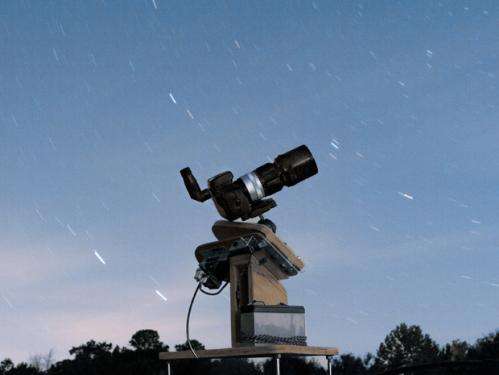Credit: David Schneider
David Schneider, a senior editor at IEEE Spectrum, was interested in exoplanets, planets that orbit stars other than the sun, but figured this kind of exercise as a home-based project was going to need expensive telescopes; he stumbled across a project at Ohio State University, where resourceful astronomers had figured out a way to spot exoplanets using a device with a lens designed for high-end cameras. Schneider's wheels turned, thinking he might also be able to pull this off if he got his hands on a charge-coupled-device detector not research-grade, and maybe he could forget about an expensive telescope as well? He also discovered an online posting by an amateur astronomer saying he had detected a known exoplanet using a digital single-lens reflex (DSLR) camera with a telephoto lens.
So go the events leading up to Schneider's recent DIY video, which shows him successfully star-tracking with a telephoto lens and barndoor tracker—otherwise known as two pieces of plywood hinged together. Without the aid of a high powered telescope, then, "You yourself can detect an extrasolar planet, and I'm gonna show you how," he tells viewers, showing a little telephoto lens. He holds up two pumpkins, one smaller than the other. "If you're very lucky, the planet, as it orbits its star, will come directly in front of the star, as viewed from earth—in which case, the amount of light coming from that star diminishes, very briefly as the planet passes in front of it. But that signal could be big enough for you to detect with a DSLR camera. The lens that comes with your camera probably isn't going to do it." Instead, he said, you can inexpensively purchase a 300-millimeter Nikon telephoto lens, along with a Nikon-to-Canon adapter.
For next steps, cost-conscious Schneider looked for DIY alternatives to an expensive tracker and went for two pieces of plywood, which he referred to as his barndoor tracker. To drive the tracker, he pulled gears out of a defunct inkjet printer, added an Arduino microprocessor, wooden platform and ball head to orient the camera in any direction. He said he used software that came with his camera, allowing adjustments to camera settings, taking shots, recording images directly to a computer and programming a sequence of timed exposures.
Schneider's goal? "A gas giant that belongs to a binary star system variously named HD 189733, HIP 98505, or V452 Vulpeculae, depending on the star catalog." (His article in IEEE Spectrum noted that, 63 light-years away, HD 189733 is too dim to be seen with the naked eye. Finding it required the use of such waypoints as the Dumbbell Nebula.) He used Iris software to perform corrections needed to calculate the brightness of HD 189733 as well as four reference stars. "So," he concluded "it seems my home-brew observatory did detect an exoplanet—using little more than run-of-the-mill DSLR and a $92 eBay camera lens."
More information: IEEE Spectrum, spectrum.ieee.org/geek-life/ha … y-exoplanet-detector
© 2014 Phys.org























